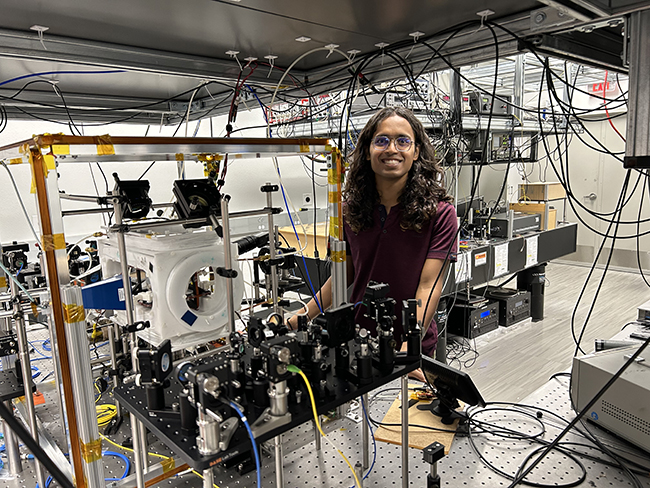News from the Chair
Francisco Elohim Becerra Awarded Department of Defense Research Grant

Grad student Sudhan Bhadade working on the cold-atom experimental platform in the Quantum Optics laboratory at UNM
 Associate Professor of Physics and Astronomy Francisco Elohim Becerra has been awarded $800,000.00 for a research project entitled "Nonclassical atomic spin ensembles based on coherent feedback and quantum eraser". This is a Department of Defense Research and Education Program for Historically Black Colleges and Universities and Minority-Serving Institutions (HBCU/MI) Grant.
Associate Professor of Physics and Astronomy Francisco Elohim Becerra has been awarded $800,000.00 for a research project entitled "Nonclassical atomic spin ensembles based on coherent feedback and quantum eraser". This is a Department of Defense Research and Education Program for Historically Black Colleges and Universities and Minority-Serving Institutions (HBCU/MI) Grant.
The Quantum Optics team at UNM will utilize quantum eraser protocols to generate collective atomic states with strong quantum correlations of cold cesium atoms, such as spin squeezed states. These states can be used for building atomic quantum sensors whose sensitivities go far beyond the limits of current sensing techniques.
In quantum eraser protocols, the entanglement carried by the light generated from its interaction with atoms is transferred back to the atoms to some degree via a second interaction. Any information left in the light about the atoms can be completely erased by measurement-based feedback. This procedure, termed quantum eraser, can in principle produce an exponential growth in the level of squeezing, which substantially enhances the sensitivity of atomic sensors.
Spin squeezing can have a large impact in metrological technologies such as atomic-based sensors for atomic clocks, inertial sensors, magnetometers, and gravimeters. These sensors are highly precise, but is precision is limited by the intrinsic quantum noise always present in sensors using many atoms to increase signal to noise.
For instance, current atomic clocks use the fundamental separation between two hyperfine energy levels in the ground state of cesium atoms to define the second as the duration of a given number of oscillations in this transition. Spin squeezing can further improve the precision of these and other atomic sensors.
This project builds on the expertise in the Quantum Optics Laboratory at UNM in quantum measurements with measurement-based feedback, and Atomic Physics with cold atoms for quantum memories, entanglement generation, and quantum metrology.
